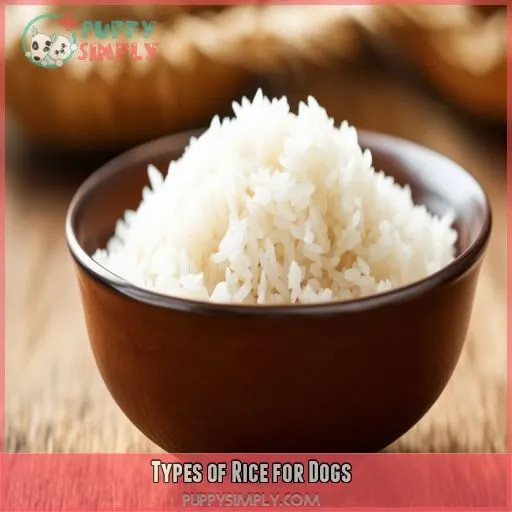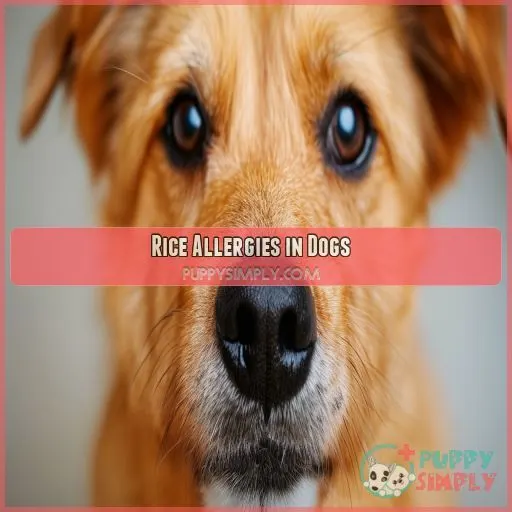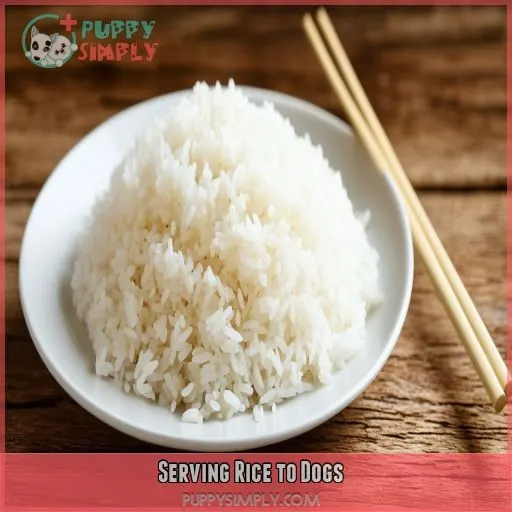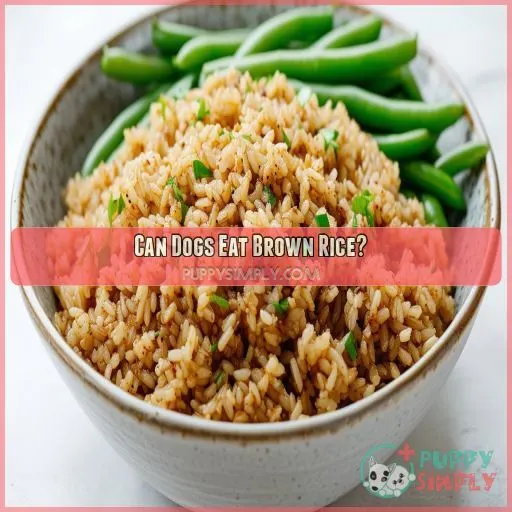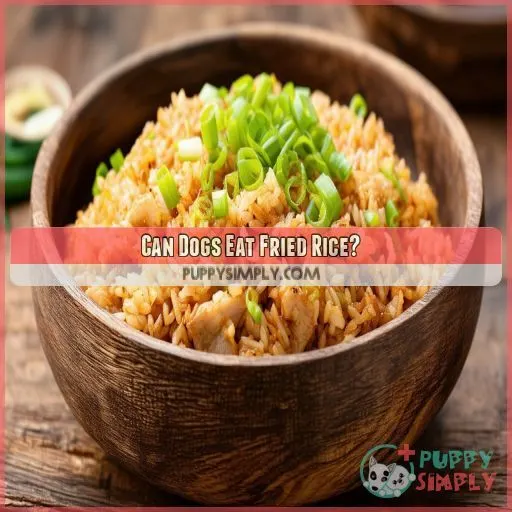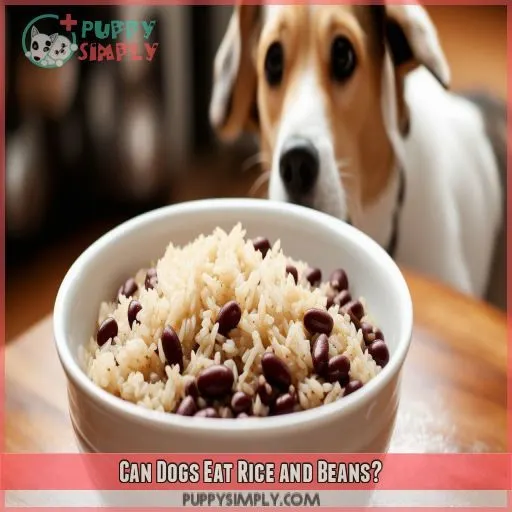This site is supported by our readers. We may earn a commission, at no cost to you, if you purchase through links.
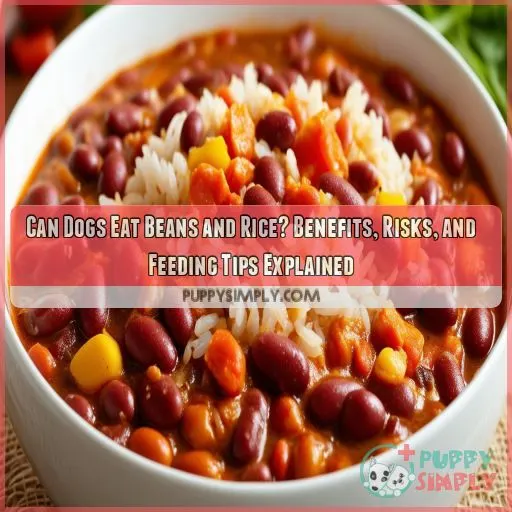 Do you ever wonder and get curious about feeding beans and rice to your dog? Well, you are certainly not the only one. You being a concerned pet parent, safety ought to be the closest word describing your mindset while feeding your furry buddy.
Do you ever wonder and get curious about feeding beans and rice to your dog? Well, you are certainly not the only one. You being a concerned pet parent, safety ought to be the closest word describing your mindset while feeding your furry buddy.
Let us now look into which rice and beans are suitable for dogs, their potential health benefits, and the method of serving these to our dogs.
You will be able to learn how to safely include these foods with the rest of the dog’s meals, increase your control over his diet, and further strengthen the bond through proper nutrition
Table Of Contents
- Key Takeaways
- Can Dogs Eat Beans and Rice?
- Types of Rice for Dogs
- Health Benefits of Rice for Dogs
- Rice Allergies in Dogs
- Serving Rice to Dogs
- Can Dogs Eat Brown Rice?
- Can Dogs Eat Fried Rice?
- Can Dogs Eat Rice and Beans?
- Frequently Asked Questions (FAQs)
- What kind of beans can dogs have?
- Can dogs eat cooked rice and beans?
- Why can’t dogs eat canned beans?
- Are white beans safe for dogs?
- Can dogs eat rice?
- Can one eat beans raw?
- Can dogs eat beans?
- Can dogs eat cooked kidney beans?
- What Are the Health Benefits of Feeding Rice and Beans to My Dog?
- Is It Safe to Feed My Dog Cooked or Uncooked Rice and Beans?
- How Often Should I Feed My Dog Rice and Beans?
- Are There Any Special Preparation Instructions I Should Follow When Feeding My Dog Rice and Beans?
- Is rice or beans better for dogs with allergies?
- How does rice affect a dogs digestive system?
- Can puppies eat rice and beans safely?
- Are there any rice alternatives for dogs?
- Does rice in dog food provide sufficient nutrition?
- Conclusion
Key Takeaways
- Rice and beans can be a tasty treat for your furry friend, but don’t go overboard – moderation is key, like that one cookie you sneak after promising to diet.
- White rice is the canine equivalent of chicken soup for upset tummies, while brown rice is the superstar for diabetic doggos. Talk about a grain of truth!
- Beans are the musical fruit for humans and pups alike. Start small to avoid turning your living room into a wind symphony.
- Ditch the takeout fried rice faster than you can say "Who’s a good boy?" Homemade, plain versions are the way to go for your four-legged foodie
Can Dogs Eat Beans and Rice?
Yes, dogs can eat beans and rice, but moderation is key. This combo can be a nutritious addition to your pup’s diet, providing essential nutrients and potential health benefits.
Stick to plain, cooked varieties without added seasonings or salt. White rice is easier to digest, while brown rice offers more fiber and nutrients. As for beans, opt for black, lima, kidney, pinto, or garbanzo beans that have been soaked and cooked thoroughly.
There’s more to learn about serving this wholesome duo to your furry friend
Types of Rice for Dogs
You can feed your dog various types of rice, like white rice, brown rice, basmati rice, jasmine rice, and wild rice. Each type has different nutritional benefits, so choose the one that best suits your dog’s needs
White Rice
White rice is great for dogs with upset stomachs. It’s rich in carbohydrates, providing energy, and easy to digest, but don’t go overboard.
It’s low in fiber, so it won’t mess with digestion too much, but watch out for potential allergies.
Always rinse before cooking to remove excess starch
Brown Rice
Brown rice is more nutritious for your dog than white rice. It’s particularly beneficial if your dog has diabetes because of its lower glycemic index. Here’s why it’s a good choice:
- Higher fiber content helps with diarrhea and constipation.
- Rich in vitamins and minerals.
- Supports a balanced diet.
- Feeds less due to higher fiber
Basmati Rice
Basmati rice, long-grain and aromatic, can be a tasty addition to your dog’s diet. It’s high in carbohydrates, providing energy yet with a moderate glycemic load, making it suitable for diabetic dogs. Pair basmati rice with beans or protein for balanced nutrition. Remember to serve it plain, cooked, and unseasoned.
| Nutrient | Amount | Benefit |
|---|---|---|
| Carbohydrates | High | Provides energy |
| Glycemic Load | Moderate | Suitable for diabetic dogs |
| Fiber | Low | Easy on the digestive system |
Jasmine Rice
Jasmine rice, a long-grain white rice, high in carbohydrate content, provides an excellent energy source for dogs. It’s soft, making it easy to digest. When serving jasmine rice, mix it with healthy meats like chicken or fresh vegetables. Remember, small portions are key to balancing your dog’s diet and avoiding weight gain
Wild Rice
Wild rice is a top choice among dog food recipes due to its nutritious value and high fiber content. It’s loaded with antioxidant properties, supporting your dog’s overall health. With a low glycemic index, it’s good for controlling blood sugar. Plus, its hypoallergenic properties make it ideal for dogs with sensitivities, helping soothe gastrointestinal issues when mixed with beans
Health Benefits of Rice for Dogs
Rice is low in fat and sodium, making it a healthy addition to your dog’s diet. It also contains antioxidants that protect against disease and supports healthy bones
Low in Fat and Sodium
Rice is a fantastic energy source for dogs, low in fat and sodium. This plain grain is a healthier alternative to high-fat foods, helping maintain your dog’s weight. Whether brown or white, rice is gentle on their stomachs. Just avoid adding seasonings, and remember to include green beans for extra fiber without risking weight gain
Contains Antioxidants
In addition to being low in fat and sodium, rice also contains antioxidants that can protect your dog against disease and cognitive decline. These powerful compounds help neutralize harmful free radicals, promoting overall health. Look for rice varieties like brown and wild rice, which boast higher antioxidant content than white rice
Supports Healthy Bones
Rice supports your dog’s healthy bones by providing essential nutrients. Calcium,
Soothes Gastrointestinal Issues
Rice is excellent for soothing your dog’s gastrointestinal issues. If your furry friend is experiencing an upset stomach, a bland diet of white rice and boiled chicken can help.
- Bland diet: white rice and boiled chicken, easy on digestion.
- Fiber content: brown rice aids both diarrhea and constipation.
- Nutritional value: rice supports recovery, maintaining caloric intake
Rice Allergies in Dogs
While rice has many benefits for dogs, you do need to be aware of sensitivities and allergies that individual dogs may develop. Some dogs form adverse reactions to rice, typified by vomiting, itchiness of the skin, inflamed paws with dry skin, and rashes. Consider hypoallergenic grains and replacements like sweet potatoes or quinoa if your dog shows signs of digestive upset or allergic reaction.
If your pup has a known rice allergy, steer clear and opt for safe options that align with their dietary needs. Other beans can replace it, such as black beans, kidney beans, and pinto beans, provided they aren’t a part of their daily diet, and one observes any changes in health and behavior with the dog.
Serving Rice to Dogs
When serving rice to dogs, always rinse it before cooking to remove excess starch. Avoid giving them fried rice or any rice with added seasonings, as these can be harmful to their health
Rinse Rice Before Cooking to Remove Excess Starch
Before cooking rice for your dog, always rinse it to remove excess starch. This step is essential for white rice, brown rice, and even wild rice. Doing this:
- Helps prevent gastrointestinal issues.
- Improves the rice’s texture.
- Enhances its health benefits, making it easier to digest
Avoid Fried Rice or Rice With Added Seasonings
Avoid fried rice or rice with added seasonings like soy sauce when serving your dog. These can lead to rice allergies, health risks, and unbalanced nutrition. Stick to cooking methods that maintain nutritional balance, portion control, and safety. Fresh ingredients like black beans, navy beans, chicken, or cheddar are better choices than seasoned or fried rice for healthy servings
Can Dogs Eat Brown Rice?
Yes, dogs can eat brown rice, which is particularly good for dogs with diabetes due to its lower glycemic index. Brown rice also offers more vitamins, minerals, and fiber than white rice, but you’ll need to feed it in smaller amounts because of the higher fiber content
Better for Dogs With Diabetes
Brown rice is great for dogs with diabetes due to its low glycemic index. It helps stabilize blood sugar levels and supports a balanced, low carbohydrate diet. Incorporating brown rice into homemade dog food can enhance its nutritional value, benefiting dogs with inflamed paws or dry skin and minimizing hair loss and hot spots
More Vitamins, Minerals, and Fiber Than White Rice
Brown rice provides more vitamins, minerals, and fiber than white rice. These nutritional differences make it a better choice for diabetic diets, as its lower glycemic index supports stable blood sugar levels. Additionally, the extra fiber aids in digestive support, ensuring your dog stays healthy. Consider brown rice for a wholesome treat during snack time
Feed Less Brown Rice Due to Higher Fiber Content
While brown rice is more nutritious, the increased fiber means you should feed less of it to your furry friend. Too much fiber may upset their stomachs, so balance is the most crucial aspect.
Regarding dogs with diabetes, brown rice’s lower glycemic index is a positive characteristic.
However, considering that dogs aren’t designed for vegetarian diets, rice should not be their only source of nutrition
Can Dogs Eat Fried Rice?
When introducing fried rice to your dog’s diet, start with a small amount to assess their tolerance. It’s best to avoid fried rice from takeout restaurants, as it often contains ingredients that can be harmful to dogs
Start With a Small Amount to Test Tolerance
When introducing fried rice to your dog’s diet, start with a small portion to gauge their tolerance. Begin with a teaspoon or tablespoon, depending on your dog’s size. Monitor for any allergic reactions or digestive issues.
Veterinary recommendations suggest gradually increasing portion sizes if no adverse effects occur
Avoid Fried Rice From Takeout Restaurants
You should avoid giving your dog fried rice from takeout restaurants. It’s often loaded with seasonings, soy sauce, and oils that can upset your pup’s stomach.
Instead, consider making homemade fried rice using dog-friendly seasonings and leftover rice. If your furry friend needs a bland diet, stick to plain, boiled rice
Can Dogs Eat Rice and Beans?
You can safely mix fresh, Cooked beans with rice for your dog, but avoid using canned beans due to their high sodium content. While beans can be a nutritious addition to your dog’s diet, they shouldn’t be given daily and should only make up a small portion of their meals
Fresh, Cooked Beans Can Be Mixed With Rice
While fried rice isn’t ideal for your furry friend, you can mix fresh, cooked beans with rice for a nutritious meal. Aim for a 3:1 rice to bean ratio, using varieties like kidney or black beans.
This combo offers fiber and protein, but watch out for flatulence! To mitigate gas, soak beans before cooking.
It’s a cost-effective option, but remember: moderation is key to avoid digestive issues
Avoid Canned Beans Due to High Sodium Content
Freshly cooked beans may work mixed into rice for your dog, but canned beans shouldn’t be given to your furry friend because of their high level of sodium; they’ll not positively serve your dog. Besides, for your dog to keep a balanced diet, opt for unsalted beans. Below are four reasons why you shouldn’t give canned beans to your dog:
- Excessive ingestion of sodium
- Upset digestive system
- Potential dehydration
- Unnecessary additions and preservatives
Beans Should Not Be Consumed Daily
While beans can be a healthy addition to your dog’s diet, they shouldn’t be a daily staple.
Excessive bean consumption may lead to gas, weight gain, and potential gastrointestinal issues. Some dogs might even have allergic reactions to certain beans.
This approach helps maintain a balanced diet and keeps your pup’s glycemic index in check
Frequently Asked Questions (FAQs)
What kind of beans can dogs have?
Like a bean buffet for your furry friend, dogs can enjoy black, lima, kidney, pinto, and garbanzo beans. You’ll want to soak and cook them first to aid digestion. Serve sparingly, as they’re best as occasional treats
Can dogs eat cooked rice and beans?
You can feed your dog cooked rice and beans in moderation. They’re nutritious, but shouldn’t exceed 10% of daily calories. Stick to plain, unseasoned varieties. Watch for digestive issues and adjust portions accordingly. It’s a healthy occasional treat
Why can’t dogs eat canned beans?
You shouldn’t feed your dog canned beans due to their high sodium content. It’s not good for their health and can lead to dehydration or more serious issues. Stick to fresh, cooked beans instead for a safer treat
Are white beans safe for dogs?
Yes, white beans are safe for dogs when properly prepared. You can feed your furry friend cooked, plain white beans in moderation. They’re a good source of fiber and protein, but don’t overdo it—they might cause gas
Can dogs eat rice?
Yes, dogs can eat rice. It’s a safe, easily digestible carbohydrate that provides energy. You can feed your pup small amounts of plain, cooked rice daily. It’s especially helpful for soothing upset stomachs
Can one eat beans raw?
About 20% of raw beans contain toxic compounds. You shouldn’t eat beans raw as they’re hard to digest and can cause severe stomach issues. Always cook beans thoroughly to eliminate toxins and improve their nutritional value
Can dogs eat beans?
Yes, dogs can eat beans in moderation. They’re packed with fiber and protein, but don’t overdo it. Cook them thoroughly and avoid canned varieties. Start with small amounts to prevent digestive issues. Always consult your vet first
Can dogs eat cooked kidney beans?
Variety is the spice of life," and that includes your dog’s diet. You can feed your furry friend cooked kidney beans in moderation. They’re packed with protein and fiber, but shouldn’t exceed 10% of daily calorie intake
What Are the Health Benefits of Feeding Rice and Beans to My Dog?
Feeding your dog rice and beans can boost their fiber intake, aid digestion, and provide essential nutrients. You’ll give them a protein boost, support heart health, and potentially manage weight. Just remember to serve in moderation and prepare properly
Is It Safe to Feed My Dog Cooked or Uncooked Rice and Beans?
A stitch in time saves nine." Cook rice and beans thoroughly before feeding your dog. Uncooked beans can be toxic, while raw rice may cause digestive issues. Serve in moderation, ensuring they’re plain and free from seasonings
How Often Should I Feed My Dog Rice and Beans?
You shouldn’t feed your dog rice and beans daily. Offer them as an occasional treat, no more than 1-2 times a week. Keep portions small, about 10% of their daily calorie intake. Monitor for digestive issues
Are There Any Special Preparation Instructions I Should Follow When Feeding My Dog Rice and Beans?
You’ll be the ultimate doggy chef! Rinse and soak beans overnight, then cook them thoroughly. Prepare rice separately, avoiding seasonings. Mix in moderation, serving no more than 10% of your pup’s daily calories. Always introduce new foods gradually
Is rice or beans better for dogs with allergies?
For dogs with allergies, rice is often the safer choice. It’s less likely to trigger reactions and easier to digest. Try plain, cooked white rice first. If tolerated, you can introduce beans gradually, starting with small amounts
How does rice affect a dogs digestive system?
Rice soothes your dog’s upset stomach and aids digestion. It’s easily digestible, providing quick energy. You’ll notice firmer stools and less gas. But don’t overdo it – too much can lead to constipation or weight gain
Can puppies eat rice and beans safely?
Ever wondered about puppy nutrition? You can safely feed your puppy small amounts of cooked rice and beans. They’re nutritious, but don’t overdo it. Start with tiny portions, watching for any digestive issues. Stick to plain, unseasoned varieties for your pup’s health
Are there any rice alternatives for dogs?
You can offer your dog alternatives to rice like quinoa, oatmeal, or sweet potatoes. These options provide similar nutrients and digestive benefits. Just introduce them gradually and in moderation, always monitoring your pup’s reaction to new foods
Does rice in dog food provide sufficient nutrition?
You’ll be surprised to know that rice is a significant ingredient in most the commercial dog food, between 30-70%. Although it provides some energy, it doesn’t complete the nutrition alone. For the best health benefits, some balancing with proteins, fats, and other nutritional elements should be furnished for your dog’s optimal health.
Conclusion
Ultimately, though, even with beans and rice, there’s a proper way to go about them. You learned which types are safe, their possible benefits, and serving methods to ensure your furry friend will be fine.
Always remember: introduce new foods gradually, and in moderation. By making better decisions regarding your dog’s diet, including beans and rice, you’re working toward advanced health and better bonding with your dog.
Always seek advice from your vet regarding the nutritional needs of your dog

